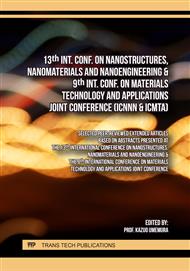p.3
p.17
p.39
p.45
p.51
p.59
p.67
p.75
Enhanced Dielectric Performance of Titanium/Graphene Oxide/Nanocellulose Composites for Advanced Capacitor Applications
Abstract:
This study focuses on developing a composite material using graphene oxide (GO) as a dielectric film. First, GO was mixed with DI water and dried to form a film. Then, a titanium (Ti) film was deposited on the film surface through electron beam evaporation. The composite comprising graphene oxide with the Ti metal film was then dispersed in water, to which cellulose nanofiber (CNF)—noted for its high mechanical strength, stability, and lightweight attributes—was added. The mixture was then re-layered with cellulose nanofibers by agitating it in water, and subsequently dried to form a composite film. The electrical properties of the material were studied using an LCR meter. The results show that pure GO has a dielectric constant of about 1600 at 1 kHz and a dielectric loss of about 25. After adding Ti, the Ti composite film maintained a dielectric constant above 1000 at 1 kHz while significantly reducing the dielectric loss to 1.5. Additionally, the resistivity of pure GO at 1 kHz is approximately 1200 Ω·m, whereas the Ti composite film with Ti and cellulose nanofibers shows a resistivity as high as 50 k Ω·m at 1 kHz. The relationship between dielectric strength and resistivity indicates that the Ti composite film can withstand higher voltages compared to pure GO, demonstrating a significant increase in dielectric strength. Compared to graphene oxide, the Ti composite film combines high dielectric constant, low dielectric loss, and increased dielectric strength.
Info:
Periodical:
Pages:
45-49
Citation:
Online since:
March 2025
Authors:
Price:
Сopyright:
© 2025 Trans Tech Publications Ltd. All Rights Reserved
Share:
Citation:



